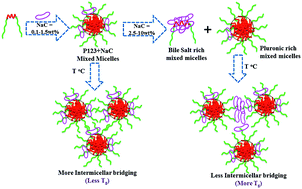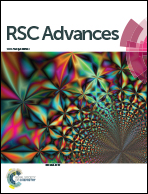An investigation of Pluronic P123–sodium cholate mixed system: micellization, gelation and encapsulation behavior†
Abstract
The effect of sodium cholate (NaC) on the micellization and gelation characteristics of Pluronic P123 in aqueous media has been explored using tensiometry, rheology, dynamic light scattering (DLS), and densitometry. The aggregation characteristics were altered drastically with the addition of NaC as signified by an increase in the critical micelle concentration (CMC), critical micellization temperature (CMT) and critical gelation temperature (CGT). The results were explained on the basis of electrostatic and steric destabilization of P123 micelles by NaC. The apparent hydrodynamic diameter (DH) of P123 + NaC binary systems decreased upon addition of NaC up to 1.5 wt%. Further, in addition to an increase in DH, the presence of two types of scattering species was also evidenced with increase in NaC concentration from 2.5–10 wt%. The effect of NaC on the encapsulating capacity of P123 was also studied using naproxen and pyrene as two model hydrophobes. The work could give a sound understanding about the interaction and self-assembling behavior of Pluronics with the important physiological component i.e., bile salts which is important to consider in any pharmaceutical formulation involving Pluronics as drug delivery agents.


 Please wait while we load your content...
Please wait while we load your content...